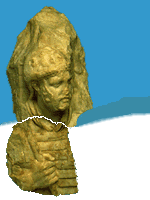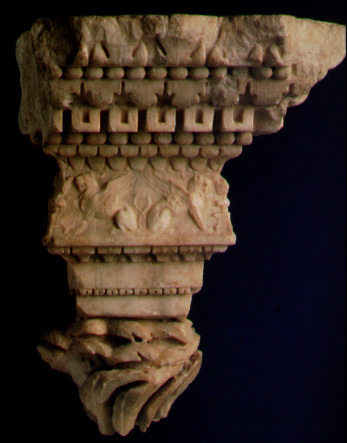

1. Corner Entablature Fragment with Part of a Capital (MNR 310254)
max. h. 0.24 m; max. w. 1.029 m; max. d. 0.337 m
Pentelic marble
The piece is broken on one side, where it was attached to the building; the rear surface is missing; the upper part of the cornice, as well as other areas, is cracked; the lower part of the capital is damaged.
 The
corner entablature, decorated on all sides, respects all the elements
of the Corinthian order aside from the absence of a corona. This piece
belonged to the exterior corner of the structure and was probably supported
by a torso (MNR 310256). From the top, the
entablature consists of the cornice, composed of a molding and a cyma
decorated with upturned leaves, the astragal, the echinus decorated with
down-turned leaves, and dentils with hollowed centers.
The
corner entablature, decorated on all sides, respects all the elements
of the Corinthian order aside from the absence of a corona. This piece
belonged to the exterior corner of the structure and was probably supported
by a torso (MNR 310256). From the top, the
entablature consists of the cornice, composed of a molding and a cyma
decorated with upturned leaves, the astragal, the echinus decorated with
down-turned leaves, and dentils with hollowed centers.
The subcornice is composed of an astragal and cyma reversa decorated with a double row of down-turned leaves. The frieze is a continuous relief of crouching griffins. On the front, a griffin raises his front paw toward a thymiaterium, while a betyl stands behind him. On the left side, two griffins crouch back to back with tails intertwined; each griffin faces a thymiaterium that turns the respective corner (the same incense vessel straddles both sides of the frieze). On the rear side, only the front part of a griffin identical to that on the front is preserved.
There follows a molding, a cyma reversa decorated with a row of lotus flowers, the first fascia of the architrave, an echinus decorated with a vegetal motif, and the second fascia of the architrave. The capital is composed of palm fronds articulated by deep drill channels that create a sense of movement.
 The
griffins represent a recurrent motif in Roman decorative art. Their symbolic
meaning is connected with the apotheosis of the deceased and was ultimately
coopted as a symbol of imperial apotheosis. In the interior precinct of
the Ara Pacis, griffins were incorporated into the decoration of
its cornice. The most famous monuments decorated with the griffin motif
are the frieze of the Basilica Ulpia in the Forum of Trajan (C. Leon,
Die Bauornamentik des Trajansforum, Vienna, Cologne, and Gratz
1966, p. 68, Typ. H, pl. 11, 3 and 12, 1, 2, and 3) and the frieze of
the Temple of Antoninus and Faustina, where griffins flank a candelabrum.
The
griffins represent a recurrent motif in Roman decorative art. Their symbolic
meaning is connected with the apotheosis of the deceased and was ultimately
coopted as a symbol of imperial apotheosis. In the interior precinct of
the Ara Pacis, griffins were incorporated into the decoration of
its cornice. The most famous monuments decorated with the griffin motif
are the frieze of the Basilica Ulpia in the Forum of Trajan (C. Leon,
Die Bauornamentik des Trajansforum, Vienna, Cologne, and Gratz
1966, p. 68, Typ. H, pl. 11, 3 and 12, 1, 2, and 3) and the frieze of
the Temple of Antoninus and Faustina, where griffins flank a candelabrum.
Dentils with hollowed centers are rare and specific to the Domitianic period. A fragment from the Vatican Necropolis (M. Guarducci, RendPontAcc 29, 1956-57, p. 121, fig. 6) and a cornice fragment from Ostia (Leon, p. 135, pl. 54, 3) reveal this same characteristic, with the addition of two ringlets between each dentil that can perhaps be attributed to the taste of the architect Rabirius.
Bibliography
Hartwig 4-25, pl. III, 1; Koeppel (1980) 15-16, 19; 21, n. 6, fig. 6; Di Mino and Bertinetti (1990) 141, fig. 117 i (R. Paris), with earlier bibliography.
Catalogue entry by Rita Paris
Copyright ©1997, 2002 Ministero per i Beni Culturali e Ambientali, Soprintendenza Archeologica di Roma and the Kelsey Museum of Archaeology, University of Michigan. All rights reserved.
 |
 |
 |
 |
 |
 |
 |
 |
 |